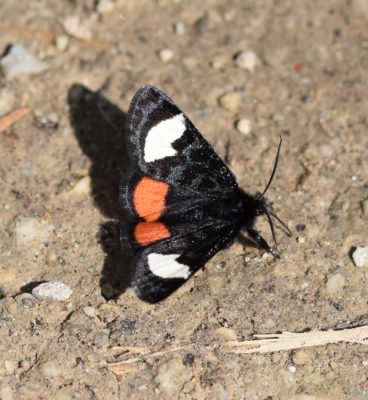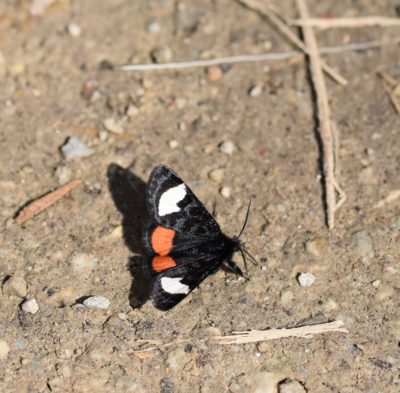Last spring I had a fleeting glimpse of what I thought was a butterfly: it was flying in the daytime and had showy white and orange or red marks. It appeared just long enough to tantalize me, then winged away from the path too quickly for me to get a good look. So I was quite pleased to find another one on April 27 puddling on the Culham trail in Riverwood in Mississauga.
What Small Black Moth Has Two Big White Marks and a Rusty Red or Orange Spot?
One thing I noticed was that the shape of this moth’s markings aren’t that obvious when it’s flying quickly away from you. The white marks are actually sort of crescent or partial ring shapes. The orange red rusty bit looks like two dots or spots but is actually a bar of colour across each hind wing.
The vivid markings made it fairly easy to identify this moth as a Grapevine Epimenis.
These moths are quite small. One could stand on my thumbnail with some room to spare. Most people who walked by while I was taking photos of the moth did not even notice it when it flew up, danced around in front of them, then circled and landed back on the path.
If it perches with its hind wings hidden, a Grapevine Epimenis could look like a black moth with only white spots, a bit like a White-spotted Sable. But if the Grapevine moth flies or opens its wings more fully— suddenly this brilliant red orange flares.
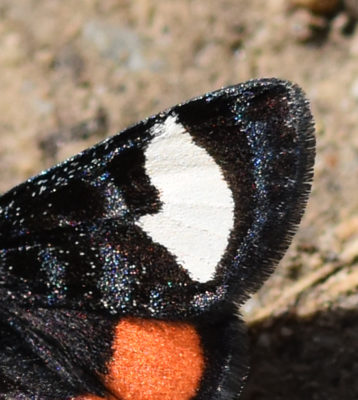
This one was so newly emerged that its wings glittered with little blue sparkles.
Quite a few moths have bright colours hidden on their hind wings. Many of them are grouped with the name “Underwing” moths for this reason.
This unexpected vivid burst of colour may be a defensive colour pattern or an attractive one. It might help startle away predators who think they are chasing one animal then are confronted with what seems to be another. Or it might be a way to attract mates and drive off rivals. I haven’t found much yet to explain if one explanation is more likely.
Where Did I See the Grapevine Epimenis Moth?
Strangely enough, although I saw three of these moths on the same April day at Riverwood Conservancy in Mississauga, none of the three was on or even really close to, a grapevine.
There are masses of Riverbank Grapevines, however, throughout the park. Lots of lovely grape leaves will emerge later this spring on which the caterpillars can feast.
The three Epimenis moths I saw were all standing on wet sandy gravel paths in quite widespread parts of the park. Like many moths do, they were tasting the damp ground with their proboscis. I believe they suck up both moisture and some minerals.
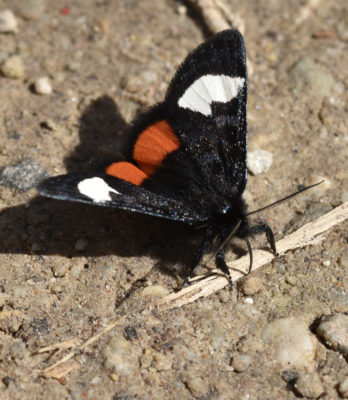
You can see it’s “drinking” from the dirt with its strawlike proboscis.
The University of Connecticut website says that adult moths will also visit plum, cherry and sumac flowers to sip nectar. It would be quite pretty to see one of these on a blossom but I don’t expect to be that lucky—at least not this year.
What’s Been Eating These Riverbank Grape Vine Leaves?
I wonder if I’ll be able to find some of the Grapevine Epimenis caterpillars later this year?
Last year I started looking at every grape vine I passed to check for the caterpillars of “Grapevine Skeletonizer” moths. They eat sections of the grape leaves leaving a sort of green lace of veins and stems behind. Pleasingly, I did find a munching herd of Skeletonizer caterpillars.
It may not be as simple to find Grapevine Epimensis caterpillars, though.
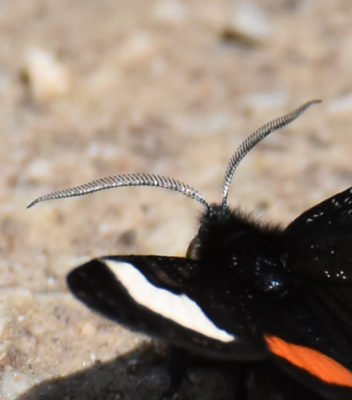
The moth’s antenna looked metallic in the bright sunshine.
I see on the BugGuide website that they are quite pretty black and white banded caterpillars with orange heads and tails. They look vaguely like Monarch caterpillars.
One image on BugGuide of leaf damage shows small round holes made in the leaf. Many types of caterpillars eat leaves that way, though. Apparently birds check leaves for damage while hunting, so many caterpillars try to eat the mid-parts while leaving the general shape of the leaf intact.
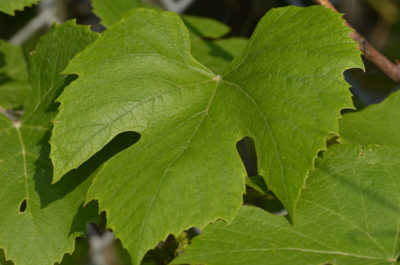
The Riverbank Grape leaf on the left already has some damage, but I saw the Plant Bug that was responsible.
According to the University of Connecticut website, a Grapevine caterpillar often makes a tent-like structure by binding a leaf or leaves together with some silk threads. They often feed while inside the structure presumably where they are less likely to be found by predators.
That could make them quite difficult to spot–especially since I would not feel right destroying a caterpillar’s “nest” to see what’s inside. My curiousity doesn’t trump their need to get on with their lives. Still, I will keep my eyes open in case I see one outside of a nest, perhaps moving to a more tasty leaf.
It’s always nice to have something else to search for in the parks. It motivates me to spend even more time outside!
Related Reading
Join In
Have you seen some of these flashy tiny moths? Please share your sighting with a comment.

